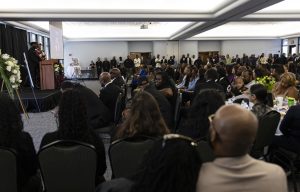Faculty works to better SCUSD middle schools
November 13, 2009
Four Sacramento State faculty members have teamed together to work with the Sacramento City Unified School District to improve middle school teaching in science, mathematics and English.
Their professional development project is funded by a four-year Improving Teacher Quality grant, recently awarded by the California Postsecondary Education Commission. The $986,120 grant is part of the federal No Child Left Behind Act.
Led by Pia Wong, professor of bilingual and multicultural education, the project will focus on improving teaching skills and boosting student achievement.
The other faculty members involved are Scott Farrand, professor of mathematics, Judi Kusnick, professor of geology and Debbie Stetson, project director for the CSUS Mathematics Project.
Shrinking the racial and ethnic achievement gap in Sacramento’s public schools is the team’s ultimate goal, said Wong.
“The achievement gap refers to the different discrepancy in scores between the highest scoring ethnicity and the lowest scoring ethnicities in the school,” Farrand said.
The highest scoring ethnic groups are usually whites and Asians and the lowest scoring ethnic groups are Latinos and blacks, said Marcia Trott, Improving Teacher Quality program administrator.
“What the California Department of Education, and therefore CPEC, are concentrating on is closing those gaps. We’re trying to bring those subgroups up to level, if not closely to the ones that are testing higher, which are whites and Asians,” Trott said.
The Sac State faculty members will work to diminish that gap by putting together seminars for teachers in four assigned SCUSD middle schools.
About 40 teachers from Rosa Parks Middle School, Fern Bacon Middle School, Kit Carson Middle School and Will C. Wood Middle School will come together to participate in the professional development curriculum in the coming years.
“It’s a chance for us to interact with our community and hopefully bring something to the community in terms of helping improve the instruction in schools,” Kusnick said.
The first year of the project will be spent researching areas that teachers are struggling with the most. The next two years, the faculty team will apply the information found through their research to create summer workshops. The two five-day workshops will focus on expanding the minds of teachers and deepening learning related to project goals and research findings.
“Our goal is to always send them home with a smile on their face and complaining that their brains hurt. That’s a good day if we do that,” Kusnick said.
In addition to the summer institutes, lesson studies and follow-up activities will also be used throughout the year. The final year of the project will be aimed at assessing the success of the faculty team’s work.
Although other similar grants have been awarded in prior years, this program’s increased focus on science and mathematics makes it different.
“A part of what this grant allowed us to do is, the science project is big on having inquiry- based learning going on in the classroom, and the math project does the same thing through questions, trying to figure out how to get kids to use mathematical reasoning and not just have the teacher do the lecture,” Stetson said.
Myra Licon, math teacher at Rosa Parks Middle School, has previous experience with Sac State’s professional development programs. She said she is eager to work with the university, especially because this new program will spotlight different methods of teaching mathematics.
Licon said professional development programs encourage teachers to make sure their students understand mathematical concepts, not just memorize rules.
She said she is excited that the program is focusing on important core subjects and hopes she will learn how to unite all three subjects to explore a cross-curricular method of teaching.
Although the project is focused on improving the teaching styles of middle school teachers, participating Sac State faculty members will see their own teaching skills improving, Kusnick said.
Wong and other faculty members said educating teachers is the first step in producing driven, college-bound students.
“Our intention is if we improve math and science instruction in the junior high schools, and through other projects that target the high schools, then we’re going to improve the likelihood that students from our service area, Sac City Unified School District, will be well prepared when they come to Sac State and also choose a math or science career,” Wong said.
Inna Gritsak can be reached at [email protected].
























































































































